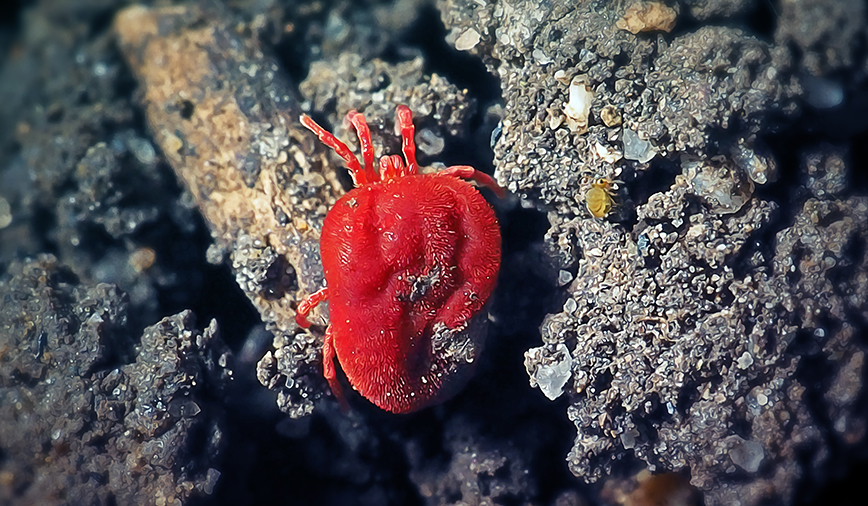Pam’s Perspective
From the…
Pam Otto is the Manager of Natural Programs and Interpretive Services for the St. Charles Park District
June 14, 2012
Lots of things happen on the trails in the Hickory Knolls Natural Area. Chipmunks and 13-lined ground squirrels sometimes choose these open areas to dig their burrows. Killdeer have used them to scrape out their bare-bones nests. And male red velvet mites have found them to be perfect spots for pitching woo, and tiny sperm packets, in hopes of attracting a mate.
With the wet weather we’ve enjoyed these past few weeks, red velvet mites are in their glory. These tiny—a few millimeters or so in length—arachnids normally lay low, conserving the moisture inside their desiccation-prone bodies. But when the rains come, so do the velvet mites, out to do what nature tells them. Along the way they wave, dance and leave miniscule trails of silken thread behind in their wake.
Red velvet mites belong to the family Trombidiidae, and a big family it is—300 species, more or less, across 10 genera. They are distant relatives of chiggers and ticks but, thankfully, show no fondness at all for human tissue.
Instead, the species in our area have a taste for insects—specifically, those that consume various fungi and bacteria on our woodland floors. Since, believe it or not, fungi and bacteria are essential cogs in the woodland ecology machine, velvet mites do us a huge favor by keeping fungivores and bacterivores in check.
So let’s get back to the good stuff—velvet mite mating rituals. Male mites know that the only way their genes will get passed along is if they somehow connect with a female. And yet…they have no copulatory organs. What’s a macho mite to do?
Instead of beefy brawn or handsome good looks, manly mites rely on artistry and
seduction. Oh, and silk. After setting down an array of spermatophores, the male produces an intricate silky trail leading back to the packets.
When a female velvet mite comes across one of these trails, she seeks out the artisan who created it. Amid much leg waving and tapping movements, the female presumably passes judgment on her gyrating swain. If he makes the grade, she sits down and accepts his genetic gifts. If not, and another male comes along, he will seek out the packages and destroy them with his mite-y ways.
However, assuming all goes well, fertile eggs and eventually little mite larvae will result. Even tinier than their teensy parents, and six-legged instead of eight, these little guys live parasitically on other arthropods such as insects, spiders or even daddy long legs. They sap a small amount of fluids, not really enough to cause harm, and often appear as no more than a speck of red on their hosts’ bodies. They pass thru three more developmental stages, protonymph, deutonymph and tritonymph, acquiring two more legs along the way before finally maturing into adults.
Perhaps because their name includes the word “mite,” or maybe because of their vague resemblance to other nuisance arachnids like clover mites (which eat plant matter and can appear in large numbers), velvet mites suffer from a reputation that’s undeservedly poor.
If you should be lucky enough to come upon them on a trail—or, even better, in your yard—let them be. They’ve found a habitat that’s to their liking, and will work to keep it healthy for both them and, inadvertently, us too. Let the pitching of woo ensue!
Pam Otto is the manager of nature programs and interpretive services at the Hickory Knolls Discovery Center, a facility of the St. Charles Park District. She can be reached at 630-513-4346 or potto@stcparks.org.

